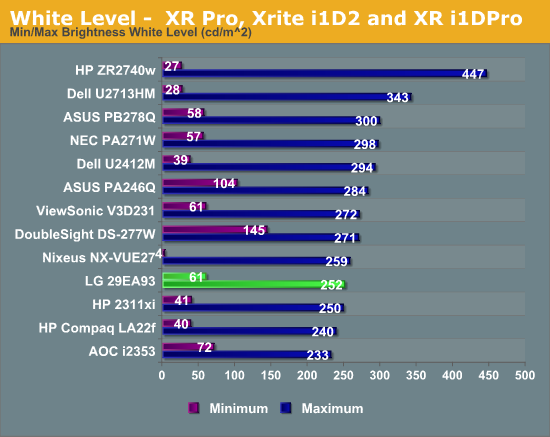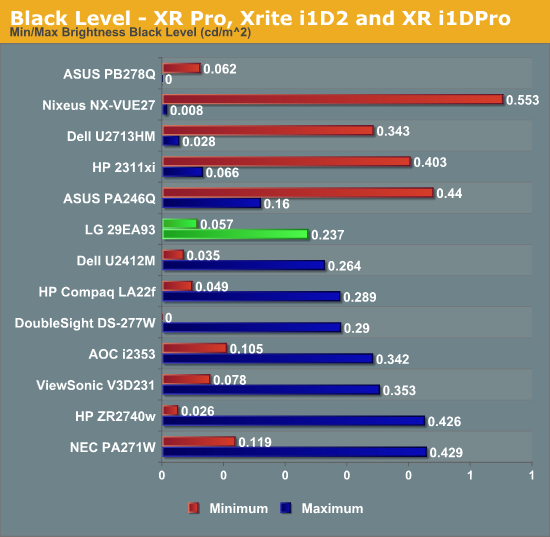LG 29EA93 Ultrawide Display - Rev. 1.09
by Chris Heinonen on December 11, 2012 1:20 AM ESTLG 29EA93—Brightness and Contrast
The LG 29EA93 uses a totally different panel and backlighting setup than any display that I’ve tested, so for once I am coming into a review without any real idea of how something will perform. With the LED backlight set to maximum with a pure white screen, the peak brightness measures at 252 nits. This is a bit lower than I expect but fine for those people without direct sunlight on the screen. With the backlight at minimum that light output level drops down to 61 nits, which provides plenty of range for users that have light controlled environments and want a dimmer display.

Black levels on the LG are pretty good in comparison to other IPS panels. The black level with the backlight at minimum is a nice 0.237 nits, and that drops all the way down to 0.057 nits with the backlight at minimum. When measured against the peak light levels and against other IPS displays, these are good black levels to see.

These numbers combine to give us a contrast ratio over 1060 for both minimum and maximum backlight levels. This puts the LG up there with the best IPS contrast ratios we have measured on any size display. The best VA displays still perform better, but IPS has managed to really improve upon contrast ratios the past few years.

Overall the peak brightness left a bit to be desired on the LG 29EA93, but the black levels and contrast ratio help to make up for that. They still won’t make it a good choice for someone that has to deal with direct sunlight on the display, but for users without that you can get plenty of brightness and a good contrast ratio from it.










90 Comments
View All Comments
markstock - Tuesday, December 11, 2012 - link
AFAIK, analog VGA is limited to 2048x1536; hence no DB-15 connector.cheinonen - Tuesday, December 11, 2012 - link
Even then most higher resolution 27" and 30" displays still include one for backup, just like they also include HDMI 1.3 ports that don't support resolutions beyond 1080p. The lack of it isn't a large negative to me, as that cuts down costs for something few people use now, but I'm sure some people would want to know.TypeS - Tuesday, December 11, 2012 - link
This LG display seems to be very narrowly targeted at just film buffs, hence its size and panel type. This really would only be nice for films that stay in the ultra-wide cinematic aspect ratio.Elsewhere you've got TV shows that are full16:9, cheap direct-to-dvd/bluray releases that are 16:9 and films like the Dark Knight and Skyfall that have scenes in IMAX that will go 16:9. In all these cases you'll get vertical letter boxing. Just my own conclusion here, but horizontal letter boxing is less intrusive than black bars on the side.
I suppose there could be some productive benefits to this, view 3 pages side by side? Or producing network diagrams and other visuals like those.
Still seems a pretty niche target audience for this monitor. Wouldn't be a good trend to start with TVs either unless everyone dropped filming in 16:9.
radbeard - Tuesday, December 11, 2012 - link
i think its narrowly targeted at office productivity buffs.peterfares - Wednesday, December 12, 2012 - link
Taller screens are better for office work.James_Edge - Tuesday, December 11, 2012 - link
Cast you mind back to the old days, what aspect did people love for work, 4:3? 16:10, no, it was 5:4 aspect, like 1280x1024, this monitor as well as being great for movies lets you take advantage of the Windows 7/8 feature to dock two Windows on the screen side by side, and on this 2560x1080 screen that is a pair of 1280x1080 windows, 5:4 dual screen is back baby and you only need a single monitor to do it! :DTegiriNenashi - Tuesday, December 11, 2012 - link
A book with landscape pages, what are you guys smoking?GullLars - Wednesday, December 12, 2012 - link
Why not use something close to Phi as the convention for aspect ratio? 16:10 (1.600) is fairly close to 1.618. 16:9 is 1.777 and is going the wrong direction with respect to what feel natural to watch and work with.Phi also works nicely as an aspect ratio if you flip a screen into portrait mode, since it maps well to A4 (1.414) with window scroll bars and utilities.
Most web pages, like AnandTech, also only uses 600-1000 pixels in the width, so wider screens as at the relevant resolutions makes no sense for browsing the web. Again, protrait mode for 1080P and 1200P works well on the web, and also many other productivity tasks.
philipma1957 - Wednesday, December 12, 2012 - link
.263 dot pitch means i can see the grid when reading print on a white screen. so this would work for movies only. I have funky eyesight due to implants.left eye sees 20-10 .
right eye sees 20-80.
so if dot ptich is not small enough the 20-10 eye will see the grid lay out.
so get a 27 inch 1440p screen with smaller dot pitch no go the print is too small on certain websites and scales like crap.
I have found a 21 inch or 22 inch 1080 p looks best for print.
comomolo - Wednesday, December 12, 2012 - link
I don't buy the reasoning about movie formats. Who watches movies sitting at their desktop? Who would use such a small display to watch movies from the sofa?The transition from 16:10 to 16:9 only makes sense because panels are cheaper when they get smaller. It has nothing to do with movies and HDTV.
This monitor makes sense only in the office, for productivity, but it's absurdly expensive for that.
Either it becomes extremely cheap or I give it no more than one year in the market. At most.
Just as a sidenote: in Europe Philips introduced some time ago LCD TVs with a 21:9 aspect ratio. Nowhere to be found today.